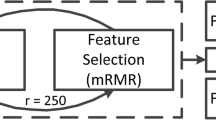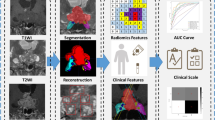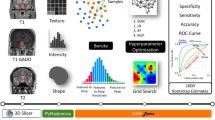Abstract
Objective
To predict silent corticotroph adenomas (SCAs) among non-functioning pituitary adenomas preoperatively using noninvasive radiomics.
Methods
A total of 302 patients including 146 patients diagnosed with SCAs and 156 patients with non-SCAs were enrolled (training set: n = 242; test set: n = 60). Tumor segmentation was manually generated using ITK-SNAP. From T1-weighted imaging (T1WI), T2-weighted imaging (T2WI), and contrast-enhanced T1WI, 2550 radiomics features were extracted using Pyradiomics. Pearson’s correlation coefficient values were calculated to exclude redundant features. Several machine learning algorithms were developed to predict SCAs incorporating the radiomics and semantic features including clinical, laboratory, and radiology-associated features. The performance of models was evaluated by AUC.
Results
Patients in the SCA group were younger (49.5 vs 55.2 years old) and more female (85.6% vs 37.2%) than those in the non-SCA group (p < 0.001). More invasiveness (p = 0.011) and cystic and microcystic change (p < 0.001) were observed in patients with SCAs. The ensemble algorithm presented the largest AUC of 0.927 among all the algorithms trained in the test set, and the accuracy, specificity, and sensitivity of predicting SCAs were all 0.867 (at cut-off 0.5). The overall model performed better than that only using semantic features available in the clinic. Radiomics prediction was the most important feature, with gender ranking second and age ranking third. Radiomics features on T2WI were superior to those on other MR modalities in SCA prediction.
Conclusion
Our ensemble learning model outperformed current clinical practice in differentiating patients with SCAs and non-SCAs using radiomics, which might help make appropriate treatment strategies.
Key Points
• Radiomics might improve the preoperative diagnosis of SCAs by MR images.
• T2WI was superior to T1WI and CE-T1WI in the preoperative diagnosis of SCAs.
• The ensemble machine learning model outperformed current clinical practice in SCAs diagnosis and treatment decision-making could be more individualised using the nomogram.



Similar content being viewed by others
Abbreviations
- ACTH:
-
Adrenocorticotropic hormones
- AUC:
-
Area under the curve
- CE:
-
Contrast-enhanced
- MRI:
-
Magnetic resonance imaging
- NFPAs:
-
Non-functioning pituitary adenomas
- SCAs:
-
Silent corticotroph adenomas
- T1WI:
-
T1-weighted imaging
- T2WI:
-
T2-weighted imaging
- VOI:
-
Volume of interest
- WHO:
-
World Health Organization
References
Daly AF, Beckers A (2020) The epidemiology of pituitary adenomas. Endocrinol Metab Clin North Am 49:347–355
Daly AF, Rixhon M, Adam C, Dempegioti A, Tichomirowa MA, Beckers A (2006) High prevalence of pituitary adenomas: a cross-sectional study in the province of Liege, Belgium. J Clin Endocrinol Metab 91:4769–4775
Lopes MBS (2017) The 2017 World Health Organization classification of tumors of the pituitary gland: a summary. Acta Neuropathol 134:521–535
Drummond J, Roncaroli F, Grossman AB, Korbonits M (2019) Clinical and pathological aspects of silent pituitary adenomas. J Clin Endocrinol Metab 104:2473–2489
Ben-Shlomo A, Cooper O (2018) Silent corticotroph adenomas. Pituitary 21:183–193
Nishioka H, Inoshita N, Mete O et al (2015) The complementary role of transcription factors in the accurate diagnosis of clinically nonfunctioning pituitary adenomas. Endocr Pathol 26:349–355
Jiang S, Zhu J, Feng M et al (2021) Clinical profiles of silent corticotroph adenomas compared with silent gonadotroph adenomas after adopting the 2017 WHO pituitary classification system. Pituitary. https://doi.org/10.1007/s11102-021-01133-8
Cooper O (2015) Silent corticotroph adenomas. Pituitary 18:225–231
Lucas JW, Bodach ME, Tumialan LM et al (2016) Congress of neurological surgeons systematic review and evidence-based guideline on primary management of patients with nonfunctioning pituitary adenomas. Neurosurgery 79:E533-535
Raverot G, Wierinckx A, Jouanneau E et al (2010) Clinical, hormonal and molecular characterization of pituitary ACTH adenomas without (silent corticotroph adenomas) and with Cushing’s disease. Eur J Endocrinol 163:35–43
Cho HY, Cho SW, Kim SW, Shin CS, Park KS, Kim SY (2010) Silent corticotroph adenomas have unique recurrence characteristics compared with other nonfunctioning pituitary adenomas. Clin Endocrinol (Oxf) 72:648–653
Kim D, Ku CR, Park SH et al (2018) Clinical parameters to distinguish silent corticotroph adenomas from other nonfunctioning pituitary adenomas. World Neurosurg 115:e464–e471
Guttenberg KB, Mayson SE, Sawan C et al (2016) Prevalence of clinically silent corticotroph macroadenomas. Clin Endocrinol (Oxf) 85:874–880
Lambin P, Rios-Velazquez E, Leijenaar R et al (2012) Radiomics: extracting more information from medical images using advanced feature analysis. Eur J Cancer 48:441–446
Gillies RJ, Kinahan PE, Hricak H (2016) Radiomics: images are more than pictures, they are data. Radiology 278:563–577
Tian Q, Yan LF, Zhang X et al (2018) Radiomics strategy for glioma grading using texture features from multiparametric MRI. J Magn Reson Imaging 48:1518–1528
Lu CF, Hsu FT, Hsieh KL et al (2018) Machine learning-based radiomics for molecular subtyping of gliomas. Clin Cancer Res 24:4429–4436
Park YW, Eom J, Kim S et al (2021) Radiomics with ensemble machine learning predicts dopamine agonist response in patients with prolactinoma. J Clin Endocrinol Metab. https://doi.org/10.1210/clinem/dgab159
Niu J, Zhang S, Ma S et al (2019) Preoperative prediction of cavernous sinus invasion by pituitary adenomas using a radiomics method based on magnetic resonance images. Eur Radiol 29:1625–1634
Zhang S, Song G, Zang Y et al (2018) Non-invasive radiomics approach potentially predicts non-functioning pituitary adenomas subtypes before surgery. Eur Radiol 28:3692–3701
Zhang K, Shou X, Chen H et al (2020) Clinical parameters of silent corticotroph adenomas with positive and negative adrenocorticotropic hormone immunostaining: a large retrospective single-center study of 105 cases. Front Endocrinol (Lausanne) 11:608691
Knosp E, Steiner E, Kitz K, Matula C (1993) Pituitary adenomas with invasion of the cavernous sinus space: a magnetic resonance imaging classification compared with surgical findings. Neurosurgery 33:610–617; discussion 617–618
Micko AS, Wöhrer A, Wolfsberger S, Knosp E (2015) Invasion of the cavernous sinus space in pituitary adenomas: endoscopic verification and its correlation with an MRI-based classification. J Neurosurg 122:803–811
Ugga L, Cuocolo R, Solari D et al (2019) Prediction of high proliferative index in pituitary macroadenomas using MRI-based radiomics and machine learning. Neuroradiology 61:1365–1373
Schuler MS, Rose S (2017) Targeted maximum likelihood estimation for causal inference in observational studies. Am J Epidemiol 185:65–73
Fan Y, Liu Z, Hou B et al (2019) Development and validation of an MRI-based radiomic signature for the preoperative prediction of treatment response in patients with invasive functional pituitary adenoma. Eur J Radiol 121:108647
Cuocolo R, Ugga L, Solari D et al (2020) Prediction of pituitary adenoma surgical consistency: radiomic data mining and machine learning on T2-weighted MRI. Neuroradiology 62:1649–1656
Peng A, Dai H, Duan H et al (2020) A machine learning model to precisely immunohistochemically classify pituitary adenoma subtypes with radiomics based on preoperative magnetic resonance imaging. Eur J Radiol 125:108892
Funding
This study has received funding from the National Natural Science Foundation of China (no. 82073640), National Project in promoting the diagnosis and treatment of major diseases by MDT, and CAMS Innovation Fund for Medical Sciences (2021-I2M-C&T-A-025).
Author information
Authors and Affiliations
Corresponding authors
Ethics declarations
Guarantor
The scientific guarantor of this publication is Zhenwei Yao.
Conflict of interest
The authors of this manuscript declare relationships with the following companies: The author Mr. Yong Zhang, PhD, employed by GE Healthcare, MR Research, Shanghai, China, was responsible for the MRI technical support in our research.
Other authors of this manuscript declare no relationships with any companies, whose products or services may be related to the subject matter of the article.
Statistics and biometry
One of the authors (N.Q.) has significant statistical expertise (graduated from Clinical Investigation of Harvard Medical School).
Informed consent
Written informed consent was obtained from all subjects (patients) in this study.
Ethical approval
Institutional Review Board approval was obtained.
Methodology
• retrospective
• diagnostic or prognostic study
• performed at one institution
Additional information
Publisher’s note
Springer Nature remains neutral with regard to jurisdictional claims in published maps and institutional affiliations.
Wenting Rui and Nidan Qiao contributed equally to this work as co-first authors.
Zhenwei Yao and Yao Zhao contributed equally to this work as co-corresponding authors.
Supplementary Information
Below is the link to the electronic supplementary material.
Rights and permissions
About this article
Cite this article
Rui, W., Qiao, N., Wu, Y. et al. Radiomics analysis allows for precise prediction of silent corticotroph adenoma among non-functioning pituitary adenomas. Eur Radiol 32, 1570–1578 (2022). https://doi.org/10.1007/s00330-021-08361-3
Received:
Revised:
Accepted:
Published:
Issue Date:
DOI: https://doi.org/10.1007/s00330-021-08361-3




